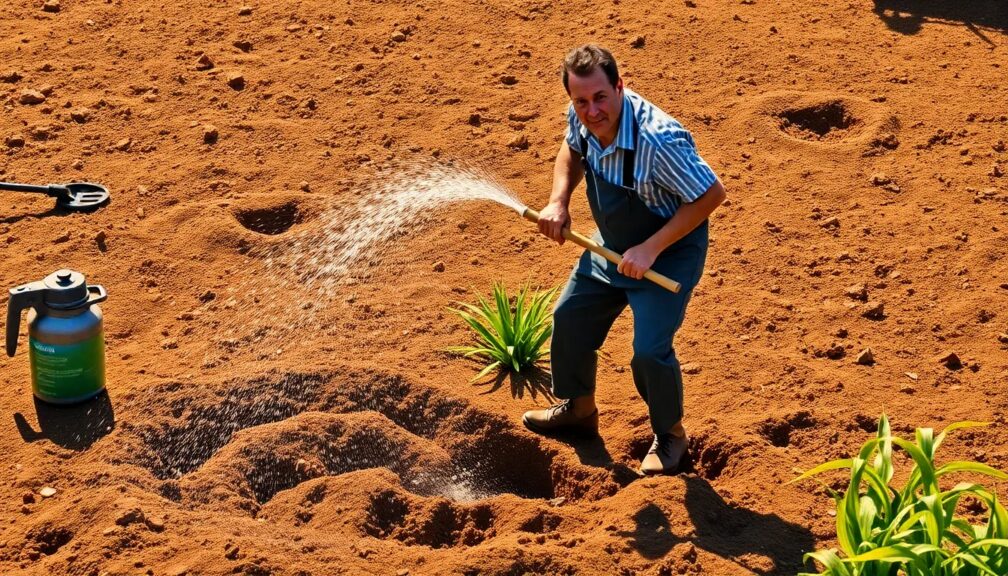How do you soften hard ground for digging

Welcome to Our Guide on How to Soften Hard Ground for Digging
Embarking on a gardening project or installing a new fixture in your yard can be a fulfilling endeavor, yet often, we are met with the challenge of hard, compacted soil that seems unyielding to shovels and spades. Before you can plant that garden, lay a foundation, or simply turn over the earth, softening the hard ground becomes a necessity. In this article, we will explore effective methods to make digging through tough soil less labor-intensive and more efficient. From pre-soaking techniques to mechanical tools, we will cover a variety of strategies suited for different types of ground conditions. Whether you are dealing with clay-heavy soil or a dry, rocky landscape, our tips will help facilitate your digging tasks and prepare the ground for whatever project you have planned.
What to do if the ground is too hard to dig?
Have you ever faced the daunting challenge of breaking through unyielding soil? Whether it's preparing a new garden bed or installing a fence post, the encounter with hard-packed earth can halt your progress and dampen your spirits. But before you throw in the trowel, know that there are effective strategies to penetrate the stubborn ground, and they're just a few lines away.
First and foremost, soak the soil. Moisture is a powerful ally. A well-watered area can transform from concrete-like hardness to a diggable state. Timing is key; an overnight soak allows water to seep deep, making your job significantly easier the next day.
Secondly, leverage the power of mechanical tools. Sometimes, manual labor won't cut it. Equipment such as a pickaxe or a powered auger can make a world of difference.
Additionally, consider the freeze-thaw cycle. If you can plan your project with the seasons, nature will do some of the heavy lifting for you. Freezing temperatures cause the ground to expand and contract, naturally breaking it up.
Don't let the hard ground keep you from realizing your backyard dreams. With the right approach, even the most stubborn earth can be conquered. And that's just the beginning. Prepare to unlock more secrets and turn the tide against the unrelenting ground. Your successful project awaits!
How to turn hard soil into soft soil?
Imagine unlocking the secrets to a bountiful garden where every plant thrives, and the key lies beneath your feet in the form of soft, fertile soil. The transformation from rock-hard clay or compacted dirt to a lush, friable haven for your plants may seem like a gardening myth, but it's a reality within your grasp.
Are you tired of watching your plants struggle to survive? Do you feel the pang of envy when you see your neighbor's garden flourishing? It's time for a change, and we're here to guide you on a journey from barren to abundant.
First, let's delve into the art of organic matter incorporation. By adding compost, well-rotted manure, or leaf mold, you're not just nourishing your garden; you're setting the stage for a radical transformation. The infusion of organic matter invites a world of beneficial organisms that play a crucial role in soil structure and plant health.
Next, consider the power of soil aeration. Penetrating compacted soil with tools like a broadfork or core aerator doesn't just relieve the soil's suffocation; it also promotes root growth and water infiltration. But the true marvel is yet to be revealed.
The addition of specific soil amendments can be a game-changer. Whether it's gypsum to break up heavy clay or a balanced fertilizer to address nutrient deficiencies, these targeted interventions can mean the difference between a struggling garden and a thriving oasis.
Have you heard of cover crops? These unsung heroes of soil health can protect and enrich your soil, and when turned under, they become green manure that enhances soil structure and fertility.
But there's more to this story – methods like mulching and no-till gardening are not just buzzwords; they are strategies that retain moisture, suppress weeds, and improve soil quality over time.
Ready to embark on this transformative journey? Stay tuned for detailed step-by-step guides, pro tips, and firsthand accounts of how turning hard soil into soft soil has revolutionized gardens just like yours. Your future garden awaits, a testament to the magic that happens when you combine patience, knowledge, and a little bit of elbow grease.
What can penetrate soil quickly and soften it?
Discover the hidden secret that gardeners and agricultural professionals have been leveraging for years. This powerhouse of penetration doesn't just soften the earth; it transforms it, creating an ideal environment for roots to spread and plants to flourish.
Imagine a solution so effective that even the most compact and unyielding soils give way to its power. This isn't a myth; it's a game changer for anyone looking to revitalize their land. Whether you're a seasoned gardener or a green-thumbed enthusiast, this knowledge can revolutionize the way you think about soil management.
But what is this mysterious agent? Here's a hint: it's not just a single entity, but a combination of techniques and substances that, when used together, produce remarkable results. We're talking about a blend of:
1. Organic matter like compost or manure, teeming with life and nutrients.
2. Aeration methods that introduce oxygen deep into the soil.
3. Natural soil conditioners that break down clay and reduce compaction.
4. The strategic use of water to maintain soil structure and consistency.
By harnessing these elements, you can create a soil profile that not only allows water and nutrients to permeate quickly but also fosters an environment where plant roots can thrive.
But wait, there's more! This is just the tip of the iceberg. To truly unlock the potential of your soil, you'll need to delve deeper into the science and art of soil management. Stay tuned, as we explore the intricacies of each element and provide you with a blueprint to achieve the lush, vibrant garden or crop yield you've always dreamed of.
Don't let this opportunity slip through your fingers. The power to transform your soil is within reach, and we're here to guide you every step of the way. Are you ready to dive in and uncover the secrets to soft, penetrable soil? Stay tuned, and prepare to be amazed at what you can achieve with the right knowledge and tools at your disposal.
How do you soften the ground for digging?
Unlock the secret to effortless excavation with techniques that'll transform your digging experience! If you've ever faced the back-breaking task of breaking through hard soil, you know it's no small feat. But what if you could turn that arduous chore into a walk in the park?
Imagine preparing garden beds or installing a new fence with ease, your shovel slicing through the earth like a hot knife through butter. The key lies in a few simple, yet ingenious methods that are just waiting to be unveiled.
Firstly, water is your unexpected ally. Moistening the soil can make an astonishing difference, but it's all about timing and technique. There's a sweet spot that turns the soil pliable without turning your work area into a mud pit.
Secondly, organic matter isn't just for healthy plant growth. Discover how integrating compost or other organic materials can drastically improve soil texture, making it more malleable and easier to work with.
And what about tools? Some are game-changers in the realm of digging. Find out which implements can reduce physical strain and multiply your effectiveness.
Don't let hard soil stand in your way. The power to transform your digging endeavors awaits, and we're just getting started. Stay tuned for the full reveal of techniques that will not only soften the ground but also soften the load on your shoulders. Are you ready to revolutionize the way you dig? Because the ground beneath your feet is about to get a whole lot friendlier.
How to soften hard ground for digging
Transforming unyielding earth into a pliable masterpiece for your gardening endeavors is a game-changer. Imagine effortlessly gliding your shovel through the once stubborn soil, ready to welcome new plant life or perhaps the foundations of your dream garden structure. The secret? Moisture, timing, and the right techniques.
Discover the profound impact of pre-soaking your ground. With a deliberate watering strategy, you can say goodbye to the backbreaking work of chipping away at dry, compacted terrain. Employing this method ahead of time works wonders, creating an environment that is much more receptive to digging.
But there's more beneath the surface. Unearth the magic of organic matter. By integrating compost or manure into the equation, you not only ease your labor but also enrich the soil, setting the stage for future growth and vitality.
And when the sun sets, the real opportunity arises. Night is the perfect ally in this quest, as cooler temperatures and dew contribute to the natural softening process. Planning your excavation for the following morning could save you hours of exertion and frustration.
Curious about mechanical aids that can further simplify the task? There are tools designed to penetrate even the most formidable ground, and we're not just talking about the traditional pickaxe. From manual options to powered devices, there's a whole arsenal waiting to be deployed.
But that's not all. The techniques you'll learn do more than ease the dig; they prevent future hardening, ensuring your soil remains welcoming to both tools and roots alike. Ready to transform your approach to gardening and discover the smart way to work with the earth? Stay tuned for transformative tips and tricks that will revolutionize your outdoor projects.
Consejo final: When dealing with hard ground, always ensure to water the area thoroughly the night before you plan to dig. This will significantly soften the soil and make your task easier. Remember, patience and the right techniques are key to success in gardening and landscaping. Take care and may your digging be ever effortless.
 What is the most popular gardening tool
What is the most popular gardening tool What should you not plant next to tomatoes
What should you not plant next to tomatoes What veggies to plant next to each other
What veggies to plant next to each other Is it better to plant vegetables in rows or groups
Is it better to plant vegetables in rows or groups How do I prepare my yard for a garden
How do I prepare my yard for a gardenIf you want to know more about similar articles like How do you soften hard ground for digging you can visit category Gardening Tools.
Deja una respuesta